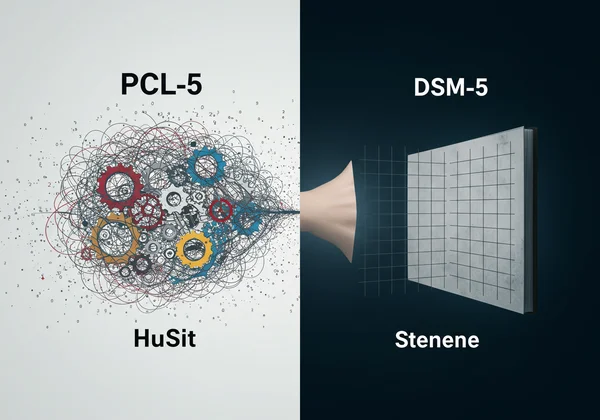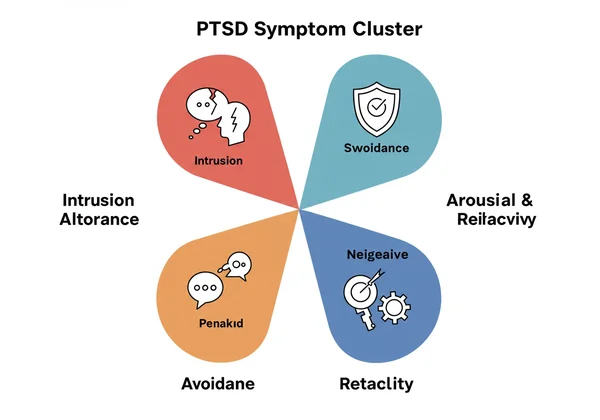什么是 PCL-5?您的创伤后应激障碍(PTSD)必备评估指南
过去的创伤经历会让您感到困惑和不知所措,脑海中挥之不去的思绪和反应难以摆脱。如果您正在寻找答案,并好奇地问: “什么是 PCL-5?” ,那么您已经迈出了寻求清晰的第一步。本指南将为您介绍 PCL-5——这一关键工具,它提供了一种结构化的方式来理解创伤后应激障碍的症状,并助您走上康复之路。
理解之路始于一个简单的行动。如果您已准备好了解这些概念如何应用于您自身,您可以 迈出第一步 ,进行一次保密的免费评估。
什么是 PCL-5 DSM-5 创伤后应激障碍评估表?
PCL-5 DSM-5 创伤后应激障碍评估表 是一种标准化的自我报告问卷,旨在衡量《精神疾病诊断与统计手册,第五版》(DSM-5)中所概述的 20 种创伤后应激障碍(PTSD)的症状。您可以将其看作是对您过去一个月经历的一次引导式回顾。它被广泛用于寻求自我了解的个人、跟踪治疗进展的临床医生以及研究创伤影响的研究人员。
这不仅仅是另一个在线测验;它是一个经过充分研究且值得信赖的工具。每个问题都经过精心设计,直接对应一个官方诊断标准,使其成为任何人在经历令人痛苦的事件后探索自身心理健康状况的可靠起点。无论您是充满好奇的个人、心理学专业的学生,还是医疗保健专业人士,这份 PTSD 评估表都提供了一个清晰、基于证据的框架。

PCL-5 评估的目的与历史
PCL-5 评估 由美国退伍军人事务部国家 PTSD 中心开发,旨在成为一个通用且强大的工具。它的创建主要有三个目标:筛查可能患有 PTSD 的个体、帮助监测症状的严重程度随时间的变化,以及协助临床医生做出初步诊断。它是旧版 PCL for DSM-IV 的现代继任者,并已更新以反映对 PTSD 的最新科学理解。
该工具的历史根植于对经历创伤者的深度承诺。它的开发确保了从退伍军人到事故平民幸存者的任何人,都能获得一种评估自身症状的可靠方法。这一背景提供了信任和专业知识的基础,这在处理敏感的个人经历时至关重要。
PCL-5 如何符合 DSM-5 标准
该工具的信誉来自于其与 DSM-5 标准 的直接对接。DSM-5 是全球心理健康专业人士用于诊断精神健康状况的权威指南。PCL-5 上的 20 个问题直接对应 DSM-5 中定义的 20 种 PTSD 症状,确保了其临床相关性和准确性。
这种一对一的对应关系意味着,当您完成评估时,您所参与的症状标准将是心理学家或精神科医生会考虑的。它提供了一种共同的语言和标准化的衡量标准,弥合了个人经历与临床评估之间的差距。这种科学依据使在线 PCL 5 测试 成为初始筛查的强大且合法的工具。

探索 PCL-5 问卷的 20 个问题
PCL-5 问卷 邀请您根据过去一个月受特定症状困扰的程度进行评分。使用简单的 5 分制量表,从 0(一点也没有)到 4(极其严重),您可以提供一个细致入微的内心世界图景。这种格式避免了简单的“是”或“否”的答案,认识到创伤的影响往往是程度的问题。
这 20 个问题并非随意设定;它们被组织成四个不同的症状类别,或称“簇”。了解这些症状簇可以帮助您看到经历中的模式,并理解创伤可能如何影响您生活的不同方面。完成问卷后,您可以立即 获取您的分数 。
理解 PTSD 的四大核心症状簇
PTSD 的症状分为四个核心簇,每个簇代表了创伤可能显现的不同方式。认识这些症状簇有助于提供更完整的病情图景。
-
闯入性症状(标准 B): 此症状簇与创伤记忆如何意外地闯入您的日常生活有关。它包括不希望出现的令人不安的记忆、噩梦、闪回,以及在回忆起事件时出现的强烈情感或生理反应。
-
回避(标准 C): 这包括积极地试图回避任何可能提醒您创伤的事物。这可能意味着回避与事件相关的想法或感受,以及避开是外部提醒物的人、地点或情境。
-
认知和情绪的负面改变(标准 D): 创伤会从根本上改变您看待自己、他人和世界的方式。此症状簇涵盖了持续的负面情绪(恐惧、惊恐、愤怒、内疚)、对活动失去兴趣、感觉与他人疏离,以及关于创伤原因或后果的认知扭曲等症状。
-
警觉性和反应性改变(标准 E): 这指的是持续处于警觉状态或易激惹状态。症状包括烦躁易怒和愤怒爆发、鲁莽行为、高度警惕(时刻保持警惕)、惊吓反应增强,以及注意力不集中或睡眠问题。

为什么 PCL-5 是宝贵的 PTSD 筛查工具
在信息泛滥的世界里,这款 PTSD 筛查工具因几个关键原因而脱颖而出。首先,它易于访问且注重隐私。进行一次 保密的在线测试 ,让您能在舒适安全的环境中探索自己的症状,这比预约咨询可能是一个更容易迈出的第一步。
其次,它能提供一个具体的结果——一个分数。这个分数提供了您当前症状严重程度的快照,并且无论您是自行管理症状还是与专业人士合作,都可以作为跟踪随时间变化的有价值基准。最后,它赋予您知识的力量。了解哪些症状最突出,可以帮助您向医生、治疗师或您关心的人清晰地表达您的经历,从而为获得更有效的支持铺平道路。

走向理解与支持的第一步
从创伤中治愈往往始于理解。PCL-5 不仅仅是一个评估表;它是一个结构化、充满关怀且基于科学的指南,有助于照亮这条道路,将令人困惑的经历转化为清晰、可操作的信息,以促进您的福祉。
在这里,您可以进行一次免费、保密且安全的 PCL-5 评估,该评估严格遵循官方 DSM-5 标准。完成测试后,您将立即收到总体的严重程度得分。对于寻求更深入理解的人,我们提供独特且可选的 AI 驱动报告,该报告可提供关于您的结果、潜在的生活影响以及可行性建议的个性化见解。
准备好获得清晰了吗?立即 开始您的保密评估 ,朝着理解和支持迈出有意义的一步。
关于 PCL-5 的常见问题解答
PCL-5 分数意味着什么?
PCL-5 分数范围从 0 到 80。分数越高,表示 PTSD 症状的严重程度越高。虽然没有一个“神奇数字”,但 31-33 分通常被视为一个阈值,表明 PTSD 症状已达到一定严重程度,值得进一步进行临床评估。然而,您的分数只是一个参考,而非最终诊断。理解个人分数的最佳方式是将其作为反思或与专业人士讨论的起点。您可以在我们的平台上 在几分钟内获得 PCL5 分数 。
PCL-5 可以诊断 PTSD 吗?
这是一个关键点: 不,PCL-5 是一个筛查工具,而不是诊断工具。 它可以高度可靠地识别 PTSD 症状的存在和严重程度,但它不能提供官方诊断。PTSD 的正式诊断只能由合格的心理健康专业人士(如心理学家、精神科医生或临床社工)在进行全面评估后才能做出。可以将该评估量表视为一个高度精确的温度计;它可以告诉您是否发烧,但需要医生来诊断病因。
谁可以管理 PCL-5?
此问卷设计得易于管理。个人可以作为自我报告问卷来完成它,这也是像我们这样的在线平台的主要目的。这种可访问性使用户能够积极参与自己的心理健康之旅。在临床环境中,治疗师、医生和研究人员也会向他们的客户或研究参与者管理此自我报告问卷,以收集数据和监测进展。易于自我管理的特点使得 尝试测试自己 变得简单。
PCL-5 涵盖的 20 种 PTSD 症状是什么?
问卷上的 20 个问题直接对应 DSM-5 中的 20 种官方 PTSD 症状。这些症状分为前面提到的四个症状簇:闯入性、回避、认知和情绪负面改变,以及警觉性和反应性改变。例如,包括出现不希望出现的记忆、回避创伤相关提醒物、感觉麻木,以及容易受惊吓。参加测试是了解所有 20 个问题的最佳方式。
理解 PCL-5 是一个强大的步骤。如果您有更多问题或想分享您的想法,请与我们联系或在下方留言。您的经历很重要,我们在这里支持您的旅程。